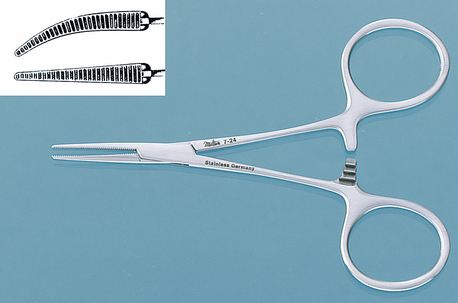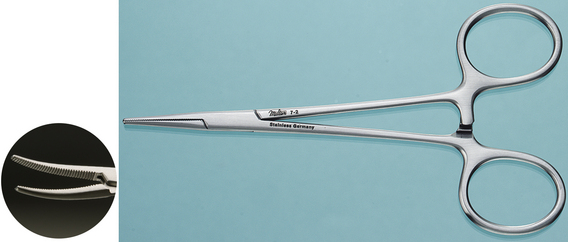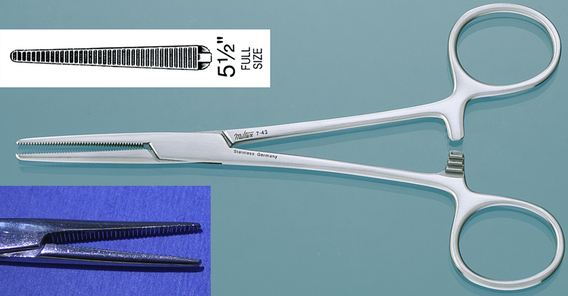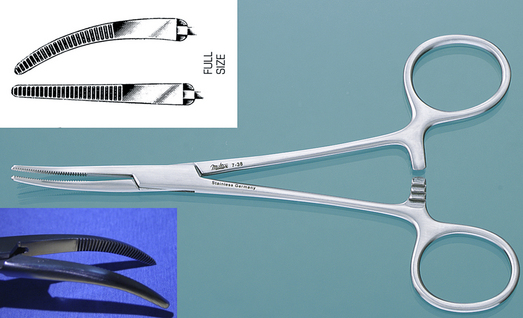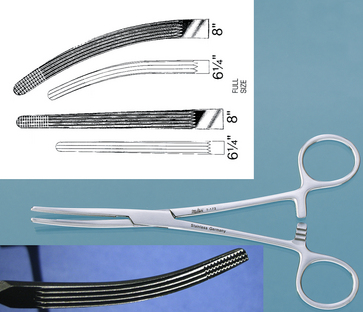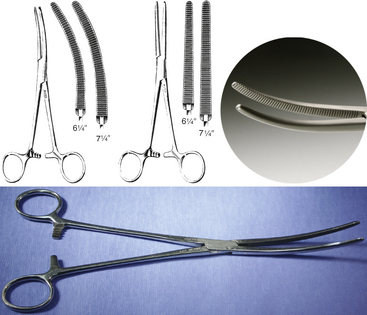CHAPTER 14 Hemostats and Forceps
Hemostatic forceps, also known as hemostats and clamps, are generally used to grasp blood vessels or to clamp and hold tissue or vessels. The instruments vary in length from 3 to 9 inches and have grooved jaws that give them holding and crushing power. The grooves on most hemostats traverse the length of the jaws, a few have grooves running longitudinally, and a few have a combination of grooves. Each is equipped with a ratchet or box lock that allows the instrument to be locked and left in place. All hemostats are available with either straight or curved jaws. The selection of size is determined by the size of the blood vessel or tissue bundle to be clamped.
INSTRUMENT
Hartman Mosquito Forceps
| FUNCTION | To clamp or occlude small capillaries or vessels that have been cut or are about to be cut. |
| COMMON NAME | Mosquito |
| CHARACTERISTICS | A forceps 3½ inches long has transverse grooves on the entire jaw. |
INSTRUMENT
Halsted Mosquito Forceps
| FUNCTION | To clamp small vessels that must be occluded, crushed, or held firmly in place. |
| COMMON NAME | Mosquito |
| CHARACTERISTICS | A forceps 5½ inches long has transverse grooves on the entire jaw. |
INSTRUMENT
Crile Forceps
| FUNCTION | To occlude vessels such as small uterine horns or small to medium-sized blood vessels. |
| CHARACTERISTICS | A forceps 6½ or 7¼ inches long has transverse grooves on the entire jaw. |
INSTRUMENT
Kelly Forceps
| FUNCTION | To occlude small to medium-sized vessels. |
| CHARACTERISTICS | A forceps 6½ inches long has transverse grooves only on the top half of the jaws; the lower half is smooth. The smooth area allows the user to clamp tubing without concern that the tubing will be cut. |
INSTRUMENT
Rochester Carmalt Forceps
| FUNCTION | To clamp large tissue bundles that have a lumen or contain blood vessels. When the instrument is placed perpendicular to the blood vessel, it occludes the vessel and prevents the blood from flowing. The other hemostats with their transverse grooves can allow blood or body fluids to continue flowing. |
| COMMON NAME | Rochester |
| CHARACTERISTICS | The first quarter of the jaws has grooves that run both longitudinal and transverse; the other three-quarters of the jaws have longitudinal grooves only. The tips of the jaws can be used to grasp and crush tissue, whereas the lengthwise grooves allow the user to slip the hemostat off after ligation. For small animals these forceps are 6¼ to 8 inches long; those used in large animals may be as long as 12 inches. |
< div class='tao-gold-member'>
Only gold members can continue reading. Log In or Register to continue
Stay updated, free articles. Join our Telegram channel

Full access? Get Clinical Tree


